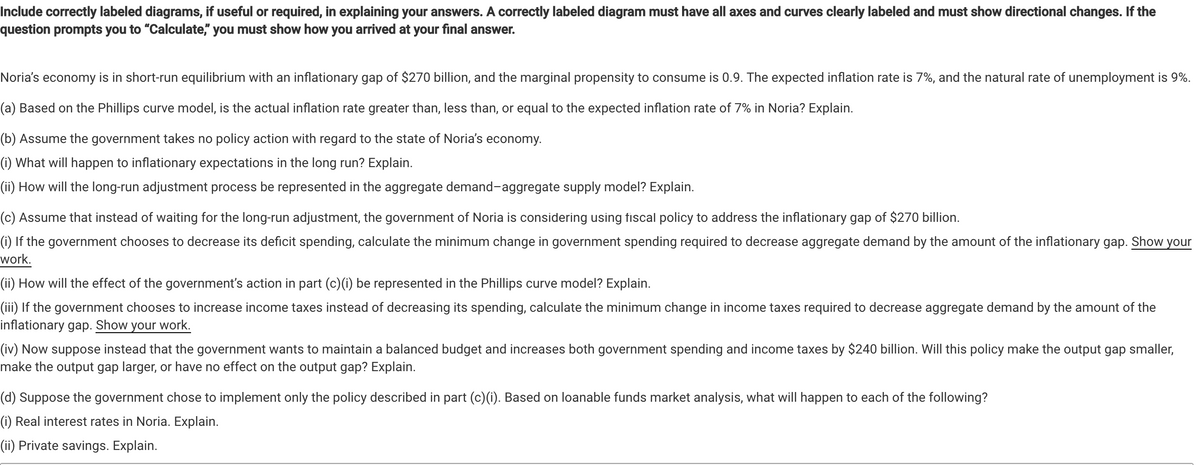Noria's economy is in short-run equilibrium with an inflationary gap of $270 billion, and the marginal propensity to consume is 0.9. The expected inflation rate is 7%, and the natural rate of unemployment is 9%. (a) Based on the Phillips curve model, is the actual inflation rate greater than, less than, or equal to the expected inflation rate of 7% in Noria? Explain. (b) Assume the government takes no policy action with regard to the state of Noria's economy. (i) What will happen to inflationary expectations in the long run? Explain. (ii) How will the long-run adjustment process be represented in the aggregate demand-aggregate supply model? Explain.
Noria's economy is in short-run equilibrium with an inflationary gap of $270 billion, and the marginal propensity to consume is 0.9. The expected inflation rate is 7%, and the natural rate of unemployment is 9%. (a) Based on the Phillips curve model, is the actual inflation rate greater than, less than, or equal to the expected inflation rate of 7% in Noria? Explain. (b) Assume the government takes no policy action with regard to the state of Noria's economy. (i) What will happen to inflationary expectations in the long run? Explain. (ii) How will the long-run adjustment process be represented in the aggregate demand-aggregate supply model? Explain.
Chapter10: Aggregate Supply
Section: Chapter Questions
Problem 2.3P
Related questions
Question
please answer the following questions based on marcroeconomic

Transcribed Image Text:Include correctly labeled diagrams, if useful or required, in explaining your answers. A correctly labeled diagram must have all axes and curves clearly labeled and must show directional changes. If the
question prompts you to "Calculate," you must show how you arrived at your final answer.
Noria's economy is in short-run equilibrium with an inflationary gap of $270 billion, and the marginal propensity to consume is 0.9. The expected inflation rate is 7%, and the natural rate of unemployment is 9%.
(a) Based on the Phillips curve model, is the actual inflation rate greater than, less than, or equal to the expected inflation rate of 7% in Noria? Explain.
(b) Assume the government takes no policy action with regard to the state of Noria's economy.
(i) What will happen to inflationary expectations in the long run? Explain.
(ii) How will the long-run adjustment process be represented in the aggregate demand-aggregate supply model? Explain.
(c) Assume that instead of waiting for the long-run adjustment, the government of Noria is considering using fiscal policy to address the inflationary gap of $270 billion.
(i) If the government chooses to decrease its deficit spending, calculate the minimum change in government spending required to decrease aggregate demand by the amount of the inflationary gap. Show your
work.
(ii) How will the effect of the government's action in part (c)(i) be represented in the Phillips curve model? Explain.
(iii) If the government chooses to increase income taxes instead of decreasing its spending, calculate the minimum change in income taxes required to decrease aggregate demand by the amount of the
inflationary gap. Show your work.
(iv) Now suppose instead that the government wants to maintain a balanced budget and increases both government spending and income taxes by $240 billion. Will this policy make the output gap smaller,
make the output gap larger, or have no effect on the output gap? Explain.
(d) Suppose the government chose to implement only the policy described in part (c)(i). Based on loanable funds market analysis, what will happen to each of the following?
(i) Real interest rates in Noria. Explain.
(ii) Private savings. Explain.
Expert Solution
This question has been solved!
Explore an expertly crafted, step-by-step solution for a thorough understanding of key concepts.
This is a popular solution!
Trending now
This is a popular solution!
Step by step
Solved in 3 steps with 1 images

Follow-up Questions
Read through expert solutions to related follow-up questions below.
Knowledge Booster
Learn more about
Need a deep-dive on the concept behind this application? Look no further. Learn more about this topic, economics and related others by exploring similar questions and additional content below.Recommended textbooks for you








Exploring Economics
Economics
ISBN:
9781544336329
Author:
Robert L. Sexton
Publisher:
SAGE Publications, Inc